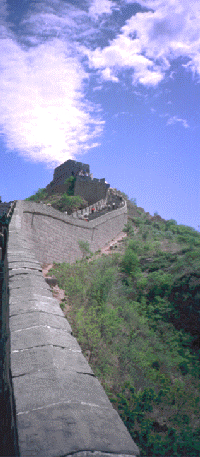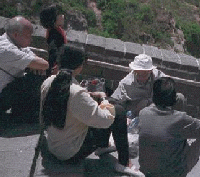
The Great Wall
Ever since she was a girl, Beth had dreamed of being able to touch the Great Wall. It is a symbol of China's greatness and of the ability of man to achieve. It functioned for hundreds of years to spare the villages the random raids of tribes from the north, lending a stability to life and continuity to the culture and government. It marked the boundary; China -- not China and its defense and maintenance for the common good united the feudal states as well as costing them wealth and untold lives. It is a wonderful dream Beth had -- to touch history.

The Great Wall is difficult to comprehend -- to photograph, impossible. At one time it stretched 12,700 li ( a li is a third of a mile) across the border between China and the Hun territories in the north. I've read that if you dismantle it and rebuild it, it could go around the entire world; probably if you stretched it by molecule it could reach Andromeda. Different guide books give different dimensions, poetically the Chinese call it the Wall of 10,000 li. The point is, it's big. It isn't one place but many. It's size is better seen on a map or from an aerial photograph. Its beauty is caught in glimpses through the mountains and clouds, its human cost is experienced through climbing it step by step.
It started as earth works thrown up for protection by different States. The individual sections weren't connected until the Qin dynasty (221-206 B.C.). Qin Shihuangdi, First Emperor of Qin, began conscripting peasants, enemies, and anyone else who wasn't tied to the land to go to work on the wall. The tradition lasted for centuries. Each dynasty added to the height, breadth, length, and elaborated the design mostly through forced labor.
There is a traditional story about Meng Jiangnü . Shortly after she and her husband were married he was conscripted to work on the wall. Meng Jiangnü worried that he would suffer from the cold in the north and began to make a padded cotton jacket. After it was sewn she began the long walk from her home in the south to the site of the Great Wall. When she got there and finally found the other men from her village, she was told that her husband had died. She went to the wall and began keening and mourning with such pathos that 20 li of the wall collapsed and in the pit at the center, she found the body of her husband. Meng Jinagnü threw herself into the sea to join her husband. Her suicide personalizes the losses due to the Great Wall.
It was during the Ming dynasty (1368-1644) that the Wall took on its present form. The brick and granite work was enlarged and sophisticated designs were added. The watch towers were redesigned and modern cannon were mounted in strategic areas. The Portuguese had found a ready market for guns and cannon in China, one of the few items of trade that China didn't already have in abundance. The Ming Emperors, having overthrown the Hun dominance and expelled their Mongol rulers of the North devoted large portions of available material and manpower to making sure that they didn't return.
Since the 1600s, parts of the Wall in some areas have been either dismantled to provide building materials in the area or have been buried by silt. We visited a restored section of the Wall at Badaling. When you stand on the Wall and look to the north you see the beginning of the great desert flatlands of the Hun. The view to the South is like a Chinese painting of layers of rolling hills covered by short brush and trees. The terrain is rough on both sides, and even today it is only accessible by a narrow road.
Throughout the centuries, armies were garrisoned along the length of the Wall to provide early warning of invasion and a first line of defense. Great piles of straw and dung used to build signal fires have been found during excavations. There must have been small garrison towns spotted along the length. There weren't many farms or trade towns to provide ease, relaxation and food. The supply trails were over mountains along narrow paths. To bring supplies to the top, ropes were slung over posts set in the Chinese side of the wall and baskets were hauled up hand over hand. Supplies must have always been short and chancy, particularly in the winter.
The Wall served well. Only when a dynasty had weakened from within were invaders from the north able to advance and conquer. Both the Mongols (Yuan Dynasty, 1271-1368) and the Manchurians (Qing Dynasty,1644-1911) were able take power, not because of weakness in the Wall but because of weakness in the government and the poverty of the people. They took advantage of rebellion from within and stepped into the void of power without extended wars.
The Wall extends from peak to peak. The height of the mountains is used to command a greater view and for its advantage in defense. Always take the high ground, particularly if you are going to use bows and arrows and javelins. It's steep. Most of us settled for climbing part of the restored section and returning, but Fred was easily able to circuit between the two major gates and return by road.

There is a holiday atmosphere on the Wall. Beth met an English teacher who had brought some of his students for a day of climbing. They had a good long talk while people climbed around them. We saw young women wearing high heels (and doing well) who were probably on dates. Some families took advantage of the availability of video recorders to document their climb. Young men and women stood at the entry to the base of the wall and for a fee would climb with you, taking your picture and pictures of the surrounding countryside.
Souvenir shops are abundant and provide a cross-section of the handcrafts available in the north. Quilts, porcelain, enamels, hats, and bright toys added color and movement to the atmosphere. While we were waiting for the others, Fred had a seal carved with his name in Chinese characters. We watched several painters at work and of course bought T-shirts proclaiming that we had "Climbed the Great Wall."
The Ming Tombs
We skipped lunch to spend more time at the Wall, but moved on for a short visit to the Ming Tombs in the afternoon. All but one of the Ming emperors are buried here. One emperor is buried outside Nanjing. Most of the outside statuary and buildings surrounding the tomb in Nanjing have been destroyed during the wars and revolutions in this century. The thirteen Ming tombs outside Beijing have been better preserved, benefitting from their remote location. Only the Ding tomb of Emperor Wan Li (Zhu Yijun) and his two wives is open to the public.
The tomb was built below ground in a great vaulted brickwork cavern. The story is that the workmen repeatedly set fire to the timber tomb which had been originally planned to put off the day of completion once the rumor spread that they would be interred in the tomb when they finished. A good plan, but then the designs where changed to use stone. The vault must be at least thirty feet high and supports a rather large hill on its roof. You enter from the top and it there seemed to be about five or six full flights of stairs to the bottom. (Fortunately, there are only two flights up to the exit -- the archaeologists provided a pleasant surprise for tourists and went through the side of the hill.) This photograph is of the Ming Archives in Beijing (to the east of the Imperial City) but the vaults bear a striking resemblance to the design used in the tomb we saw.
While the tombs are impressive, the real attraction is outside. There are wonderful gardens of recent vintage and a feeling of being inside the hills of China. There are pagodas on the top of distant hills remind you that you are in China. They are placed for prayer, contemplation, and remove from the life of the ordinary.
When a Ming emperor died, it was the death of a Son of Heaven. To provide a proper setting for the entombment, a concourse was built to be used only for the funeral processions leading to the hills in which the tombs were built. Great stone beasts and figures of ministers and warriors lined the path on either side. Their brooding presence gave stiff attention to the event. The gate at the end marked the passage to another life and the assumption of the Mandate to Rule by the new emperor. The Sacred Way is about 4 miles, measured from the gate to the entrance of the central tomb. The concourse or promenade built for the funeral processions was closed for renovations, the pictures I have included are from an earlier trip.
It was about 20° F and windy when I first walked the concourse. This gentleman gave my friend and me a ride for the return trip down the length of the concourse. I got the side car. I smile whenever I see this picture, it's a nice memory.